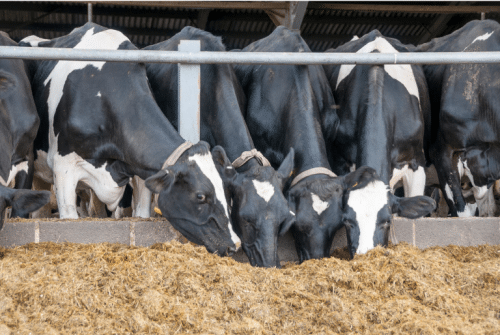After being rocked by the deadly pandemic, Michigan’s agricultural economy is rebounding.
 The recent Economic Impact of COVID-19 on Michigan Agricultural Production Sectors report detailed the impact of the pandemic on row crops, livestock, tree fruits, vegetables and dairy.
The recent Economic Impact of COVID-19 on Michigan Agricultural Production Sectors report detailed the impact of the pandemic on row crops, livestock, tree fruits, vegetables and dairy.
It was authored by Steven R. Miller, director for the College of Economic Analysis of Agriculture and Natural Resources at Michigan State University; Trey Malone, assistant professor for the Department of Agricultural, Food, and Resource Economics College of Agriculture and Natural Resources at Michigan State University; and K. Aleks Schaefer, assistant professor for the Department of Agricultural, Food, and Resource Economics College of Agriculture and Natural Resources at Michigan State University.
According to the report, dairy and vegetable production were the hardest hit, experiencing 25.2% and 27.3% declines, respectively, in estimated economic output for Michigan’s agricultural supply chain. Those declines represented losses of $464,342,000 for dairy and $108,790,000 for vegetables.
Overall, the impact on the agricultural economic output for the Michigan supply chain was a decline of 18.6%, or $1,035,893,000.
“That was a snapshot,” Malone said. “Since then, we have seen prices rebound pretty nicely for a lot of industries.”
Joe Diglio, president and CEO of the Michigan Milk Producers Association, said although milk prices are higher this year, it does not mean the dairy producers are making money because the input cost also has increased.
“Margins on the farm have been eroded because of the higher cost to produce than they saw in the previous year,” he said. “We have seen increases in prices for dairy products, but it is not enough to offset production costs at the farm level.”
Diglio said there is a misconception that milk producers are earning more in revenue. The input costs that dairy farmers have to incur for things such as animal feed, equipment, labor and machinery repairs have prevented farmers from pocketing the money they earn.
Nevertheless, general businesses have opened their doors, which is a welcome sight and step in the right direction for dairy producers who dealt with many businesses in the foodservice industry closing.
Diglio said about 40% to 50% of milk produced is used in dairy products such as cheese, which is used heavily in restaurants.
“Retail was good, but that didn’t offset the displacement of the major market in general,” he said. “There were also challenges in getting products exported. We started seeing logistical challenges throughout the supply chain, trying to get products moved from one location to another and, unfortunately, labor became a huge challenge, and it continues to be a challenge.”
Like dairy, the price for soybeans, corn and other row crops have increased. According to the MSU economic impact report, there was a 14.8%, or $325,317,000, decline in estimated economic output for the Michigan agricultural supply chain for row crops.
Michigan Soybean Association’s Steve Koeman is the owner of Koeman Farms, a 2,600-acre farm where he grows corn and soybeans, among other things. He said one of the reasons corn prices have increased is because people are driving more this year.
“Corn is used for ethanol,” he said. “Most of the gasoline we use has 10% ethanol in it, so ethanol surely got affected last year when no one was driving. The use went way down, and the corn used for ethanol went way down for a while. We have certainly rebounded from that. The amount of corn that we are using for ethanol is back where it was before the pandemic. Over a third of the U.S. corn crop gets used for ethanol, so that is a big percentage of our corn that gets turned into ethanol.”
Dan Keenan is a farmer who grows soybeans, corn, and sugar and black beets on his 1,500-acre farm. Keenan, a member of the Michigan Corn Growers Association, said corn prices also are on the rise due to exports to China.
“China’s appetite for corn, especially, has added to that,” he said. “Historically, we export soybeans to China. They made a decision that they were going to import their soybeans and be self-sufficient in growing their corn, but for whatever reason they don’t have the amount of corn they need. Nationally, we don’t export a ton of corn to China. But over the last six to eight months we have, more than we ever had, so that has led to the strongest prices we’ve seen in probably a decade.
“The other aspect is input cost. When we see the market like this we take advantage of the high crop prices, and we were lucky enough to get our inputs purchased for this year’s crop at reasonable prices.”
However, Keenan said there is an issue with the availability of parts for equipment and shipping costs have increased, and he has had to wait longer to receive the parts.
“We ordered some components for our fertilizer system on our planter this spring,” he said. “The gentleman who manufactures them is out of central Illinois and he couldn’t guarantee that they would make it to us in a timely fashion, so we actually drove down and met him in Illinois to pick them up and guarantee we would have them. That was something that we never had to deal with.”
Nevertheless, prices for dairy and row crops have rebounded this year after a very poor 2020.
“The one thing that the pandemic taught me about agriculture is how resilient the system can actually be,” Malone said. “This has been a crazy shock to everyone, yet you can still find most of the products you want on the grocery shelves. A year later, a lot of prices have come back to a place where we would have expected them to be prior to the pandemic.”
Source: Grand Rapids Business Journal




